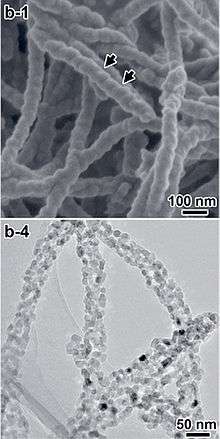Titanium butoxide
 | |
| Names | |
|---|---|
| IUPAC name
titanium(4+) butan-1-olate | |
| Other names | |
| Identifiers | |
3D model (JSmol) |
|
| ChemSpider | |
| EC Number | 227-006-8 |
PubChem CID |
|
| UNII | |
| UN number | 2920 |
| |
| |
| Properties | |
| C16H36O4Ti | |
| Molar mass | 340.32164 |
| Odor | weak alcohol-like[1] |
| Density | 0.998 g/cm3[1] |
| Melting point | -55 °C[1] |
| Boiling point | 312 °C[1] |
| decomposes[1] | |
| Solubility | most organic solvents except ketones[1] |
Refractive index (nD) |
1.486[1] |
| Thermochemistry | |
Heat capacity (C) |
711 J/(mol·K)[2] |
Std enthalpy of formation (ΔfH |
-1670 kJ/mol[2] |
| Hazards | |
| Lethal dose or concentration (LD, LC): | |
LD50 (median dose) |
3122 mg/kg (rat, oral) and 180 mg/kg (mouse, intravenal).[1] |
Except where otherwise noted, data are given for materials in their standard state (at 25 °C [77 °F], 100 kPa). | |
| Infobox references | |
Titanium butoxide is a chemical compound with the formula Ti(OBu)4 (Bu = CH2CH2CH2CH3). It is a colorless to pale-yellow liquid with a weak alcohol-like odor and density almost equal to that of water. It is soluble in most organic solvents, but decomposes in water and reacts violently with oxidizing materials.[1][3] Decomposition in water is not hazardous, and therefore titanium butoxide is often used as a liquid source of titanium dioxide, which allows deposition of TiO2 coatings of various shapes and sizes down to the nanoscale.[4][5]
Reactions and hazard

Titanium butoxide is produced by reacting titanium tetrachloride with butanol. When mixed with water it decomposes to titanium dioxide and butanol. This decomposition is not hazardous,[1] and is often used as a source of titanium dioxide.[4][5]
Tetrabutyl orthotitanate reacts with alkylcyclosiloxanes. With ocatamethylcyclotetrasiloxane it produces dibutoxydimethylsilane, 1,5-dibutoxyhexamethyltrisiloxane, 1,7-dibutoxyoctamethyltetrasiloxane, 1,3-dibutoxytetramethyldisiloxane and polymers. With hexamethylcyclotrisiloxane it also produces dibutoxydimethylsilane.[6]
Titanium butoxide is a corrosive, flammable liquid incompatible with oxidizing materials. It reacts violently with sulfuric and nitric acid, inorganic hydroxides and peroxides, bases, amines, amides, isocyanates and boranes. It is irritating to skin and eyes, and causes nausea and vomiting if swallowed. LD50 is 3122 mg/kg (rat, oral) and 180 mg/kg (mouse, intravenal); flash point is 77 °C. When heated it emits irritating fumes,[1] which form explosive mixtures with air at concentrations above 2 vol%.[3]
References
- 1 2 3 4 5 6 7 8 9 10 11 12 Butyl titanate. pubchem.ncbi.nlm.nih.gov
- 1 2 3 Tetrabutyl titanate. nist.gov
- 1 2 Pohanish, Richard P.; Greene, Stanley A. (2009). Wiley Guide to Chemical Incompatibilities. John Wiley & Sons. p. 1010. ISBN 978-0-470-52330-8.
- 1 2 3 Wang, Cui (2015). "Hard-templating of chiral TiO2 nanofibres with electron transition-based optical activity". Science and Technology of Advanced Materials. 16 (5): 054206. Bibcode:2015STAdM..16e4206W. doi:10.1088/1468-6996/16/5/054206. PMC 5070021. PMID 27877835.
- 1 2 Wu, Limin; Baghdachi, Jamil (2015). Functional Polymer Coatings: Principles, Methods, and Applications. Wiley. p. 10. ISBN 978-1-118-88303-7.
- ↑ K. A. Andrianov, Sh. V. Pichkhadze, V. V. Komarova, Ts. N. Vardosanidze (1962). "Reactions of organocyclosiloxanes with tetrabutyl orthotitanate". Bulletin of the Academy of Sciences of the USSR Division of Chemical Science. 11 (5): 776–779. doi:10.1007/BF00905301. ISSN 0568-5230.